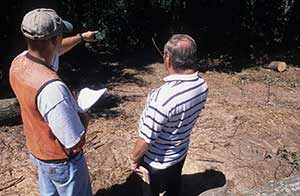Forest Plans
Do I need a forest plan?
If you think that commercial timber producers are the only people who need a forest management plan, think again. Management plans are also for guiding improvements to wildlife habitat, enhancing recreational opportunities, protecting water quality, controlling invasive species – or really anything that’s important to you.

In short, planning helps you see your property with perspective and set priorities for it. And that’s wise use of your time and money.
Moreover, plans help you look five, 10, or 20 years down the road – even beyond your ownership. Plus, you’ll need a management plan to receive financial assistance from the state or federal government to pay for conservation practices, such as tree planting or wildlife habitat improvements.
Still, the idea of drafting a plan can be intimidating. Below is some information that will hopefully ease the process.
What’s in a plan?
The details of course will vary, but every plan contains three basic things: 1) what you want from your woods, 2) what the land can do, and 3) three to six recommended actions that will get you what you want.
You may think that you don’t have any goals for your woodland, other than for nature to “take its course.” But everyone who owns wooded property has interests: to care of the land, to spot more birds, to shoot a big buck. These interests can form the basis of any number of activities.
How much does a plan cost?
Plans usually include a base price plus a per acre amount, with actual rates depending on the contractor. Typically, plan writing for a 40-acre woodland costs around $900.
You may be able to get financial help to write a plan. For example, the Natural Resources Conservation Service’s (NRCS’s) Environmental Quality Incentives Program (EQIP) provides a flat-rate of $1,346 toward the writing of a NRCS Conservation Activity Plan (CAP) for 40 acres of land. This makes your out-of-pocket expenses next to nothing.
Who writes the plan?
While NRCS will share the cost of writing a CAP, these plans are actually written by natural resource professionals outside NRCS. Specifically, the agency requires that CAPs be written by what is known as a technical service provider (TSP) – foresters who have gone through the extra training needed to write these plans. So if this plan is what you want, your first step is to contact a TSP to help you.

Other plans, however, such as stewardship plans and Managed Forest Law plans, can be written by other professional foresters (i.e., ones who aren’t TSPs). Although NRCS EQIP won’t share the cost of writing these other forest management plans, the program does offer financial assistance for carrying out certain practices under these plans, such as invasive species control.
What’s the process?
Regardless of who you hire, the forester will walk your woods with you, informing you about the trees, natural communities, and invasive species you have on your land; how healthy your woods are; and the actions you can take to protect and enhance your woodland. Again, these actions are based on what you want for your woodland – foresters are trained to match your needs and goals with the land’s potential.
After the woods walk, plans can be finalized in as little as two to three weeks depending on the forester or TSP you hire.
Can a plan be changed over time?
Plans are crafted from the best information available today, so of course they need to be revisited from time to time.
Who do I contact for more information?
Use the Wisconsin Department of Natural Resources’ Forestry Assistance Locator to find a professional forester in your area, or visit the NRCS’s Contact Us page to locate your nearest NRCS Service Center.
Thomas Wyse, Forester and TSP (Technical Service Provider), Kickapoo Woods Cooperative, contributed to this article.
